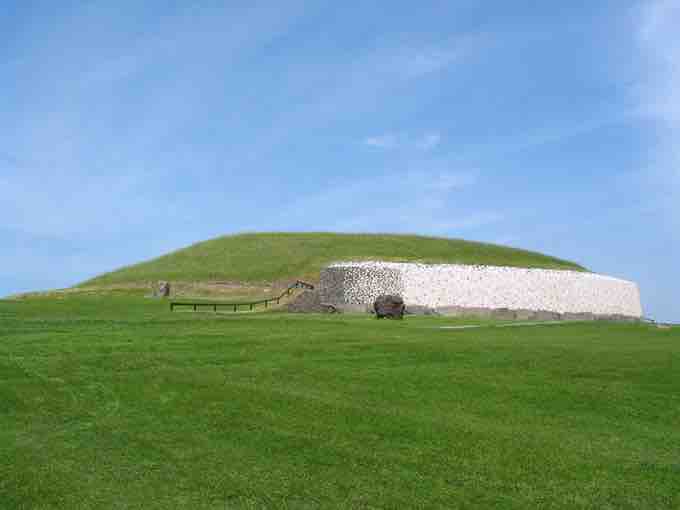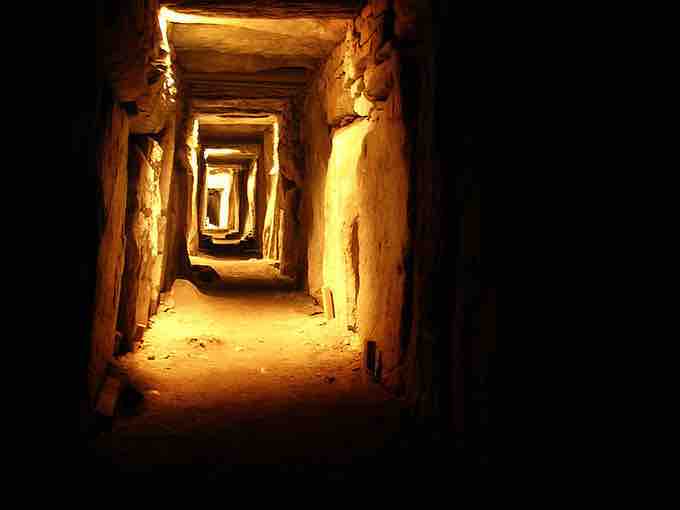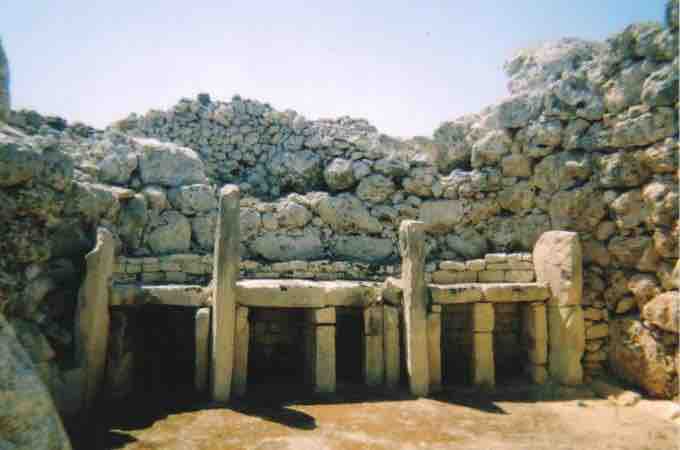The Neolithic Period
Also known as the New Stone Age, this was a period in human development that originated around 10,000 BCE lasting until 3000 BCE. Considered the last part of the Stone Age, the Neolithic is signified by a progression in behavioral and cultural characteristics including the cultivation of wild and domestic crops and the use of domesticated animals.
Agrarian societies first appeared in southeast Europe in the seventh millennium BCE. Through migration and cultural diffusion, Neolithic traditions spread west and northwards to reach northwestern Europe by around 4500 BCE. The development of agriculture allowed groups of people to form larger permanent settlements in single locations, as opposed to living as nomadic hunter gatherers. Permanent settlements resulted in the construction of megalithic monuments requiring considerable time and effort that was unavailable to nomads.
Neolithic societies produced female and animal statues, engravings and elaborate pottery decoration but in Western Europe it is best represented by its megalithic (large stone) monuments and passage tomb structures which have been found from Malta to Portugal, through France and Germany, and across southern England to most of Wales and Ireland.
Megalithic Henges
Stonehenge
Perhaps the best known megalithic henge is Stonehenge, located on Salisbury Plain in the county of Wiltshire in south central England. Archaeologists believe it was constructed from 3000 BCE to 2000 BCE. The surrounding circular earth bank and ditch, which constitute the earliest phase of the monument, have been dated to about 3100 BCE. Radiocarbon dating suggests that the first bluestones in the innermost ring of Stonehenge were raised between 2400 and 2200 BCE, although they may have been at the site as early as 3000 BCE.
Plan of Stonehenge
Key to plan: (1) The Altar Stone, (2) barrow without a burial, (3) "barrows" without burials, (4) the fallen Slaughter Stone, (5) the Heel Stone, (6) two of originally four Station Stones, (7) ditch, (8) inner bank, (9) outer bank, (10) the Avenue, (11) ring of 30 pits called the Y Holes, (12) ring of 29 pits called the Z Holes, (13) circle of 56 pits, known as the Aubrey holes, (14) smaller southern entrance.
Although human remains have been found at the site, archaeologists remain uncertain as to whether the site served funerary purposes, ritual purposes, or both. Its alignments with the sunrise of the summer solstice and sunset of the winter solstice present the possibility that the site might have also served as a rudimentary astronomical calendar to help early agrarian societies in the area acclimate to the approaching growing season and harvest.
Stonehenge
Salisbury Plain, England.
Even the smallest bluestones weigh several tons each. These stones, so-called because they appear blue when they become wet, were quarried approximately 150 miles away in the Prescelli Mountains in southwest Wales. Even more impressive, the quarrying and transport of the stones took place without the aid of the wheel, requiring a sophisticated method of transport and construction involving felled trees and earthen mounds. The larger Sarcen stones, which form the post-and-lintel ring and the free-standing trilithons, were quarried approximately 25 miles to the north of Salisbury Plain. However, the same system of felled trees and earthen mounds involved with the blue stones was still required in the transport and erection of the stones.
Avebury
One of the best known prehistoric sites in the United Kingdom, Avebury contains the largest stone circle in Europe. Located in the same county as Stonehenge, Avebury lies almost due north of the better known site. Constructed over several hundred years in the third millennium BCE, the monument comprises a large henge with a large outer stone circle and two separate smaller stone circles situated inside the center of the monument. Its original purpose is unknown, although archaeologists believe that it was most likely used for some form of ritual or ceremony. The Avebury monument was a part of a larger prehistoric landscape containing several older monuments nearby.
Avebury
Part of the south inner circle.
The chronology of Avebury's construction is unclear. It was not designed as a single monument. Rather, it was the result of various projects that were undertaken at different times during late prehistory. Experts date the construction of the central cove to 3000 BCE, the inner stone circle to 2900 BCE, the outer circle and henge to 2600 BCE, and the avenues to 2400 BCE. The construction of Avebury, as well as Stonehenge, indicate that a stable agrarian economy had developed in this region of England by around 4000 to 3500 BCE.
Passage Tombs
Passage tombs or graves consist of narrow passages made of large stones and one or multiple burial chambers covered in earth or stone. Megaliths were commonly used in the construction of passage tombs and typically date to the Neolithic. A common layout is the cruciform passage grave, characterized by a cross-shaped structure.
Newgrange, Ireland
Newgrange is part of the Neolithic Bru na Boinne complex, a collection of passage tomb mounds built around 3200 BCE and located in County Meath, Ireland .

View of Newgrange, Ireland
Newgrange is more than five hundred years older than the Great Pyramid of Giza in Egypt, and predates Stonehenge by about a thousand years.
The Newgrange monument is comprised of a large mound, built of alternating layers of earth and stones, covered with growing grass, and with flat white quartz stones studded around the circumference. The mound covers 4500 square meters of ground. Within it is a passage that stretches through the structure ending at three small chambers.
Newgrange contains various examples of abstract Neolithic art carved onto its rocks. The carvings are separated into 10 categories consisting of curvilinear forms like circles, spirals, arcs, serpentiforms, and dot-in-circles, as well as rectilinear examples such as chevrons, lozenges, radials, parallel lines, and offsets.
There is no agreement as to what the site was used for, but it has been speculated that it had some form of religious significance due to its alignment with the rising sun which floods the stone room with light on the winter solstice.
Knowth, Ireland
Knowth is a Neolithic passage grave and monument located in the valley of the River Boyne in Ireland. Located in close proximity to similar sites such as Newgrange, Knowth consists of one large cruciform passage tomb, and 17 smaller satellite tombs, estimated to date between 2500 and 2000 BCE.

View of the eastern passage, Knowth, Ireland
The east-west orientation of the passages at Knowth suggests astronomical alignment with the equinoxes.
Additionally, the monument contains three recesses and basin stones into which the cremated remains of the dead were placed. The right recess is larger and more elaborately decorated than the others, which is a typical trait of Irish passage graves. The reason, however, remains unknown. Many of the monuments at Knowth were megalithic tombs, and archaeologists speculate that most have religious significance.
Knowth is reputed to have approximately one third of all megalithic art in Western Europe carved into its rock faces. Typical motifs include spirals, lozenges and serpentiform markings. Much of the art was carved on the backs of stones, which is a phenomenon known as hidden art. There are many theories for the function of hidden art, including a possible desire to hide images or the recycling of stones in order to use both sides.
Ggantija, Malta
The megalithic temple complexes of Ggantija on the Mediterranean islands of Gozo and Malta are notable for their gigantic Neolithic structures which date to 3600 BCE.

Entrance to megalithic temple at Ggantija, Malta
The Ġgantija temples are older than the pyramids of Egypt and have been designated a UNESCO World Heritage Site.
Situated at the end of the Xanghra plateau and facing the southeast, the temples are built in a clover leaf shape, with inner facing blocks marking the shape which was then filled with rubble. They lead to a series of semi-circular apses connected by a central passage.
The temples have been theorized as the possible site of a fertility cult due to numerous associated figurines found on site. The Hypogeum of Hal-Saflieni, located in Pola, Malta, is a subterranean structure excavated circa 2500 BCE, the only prehistoric underground temple in the world, showing a degree of stone artistry unique to the Maltese islands.